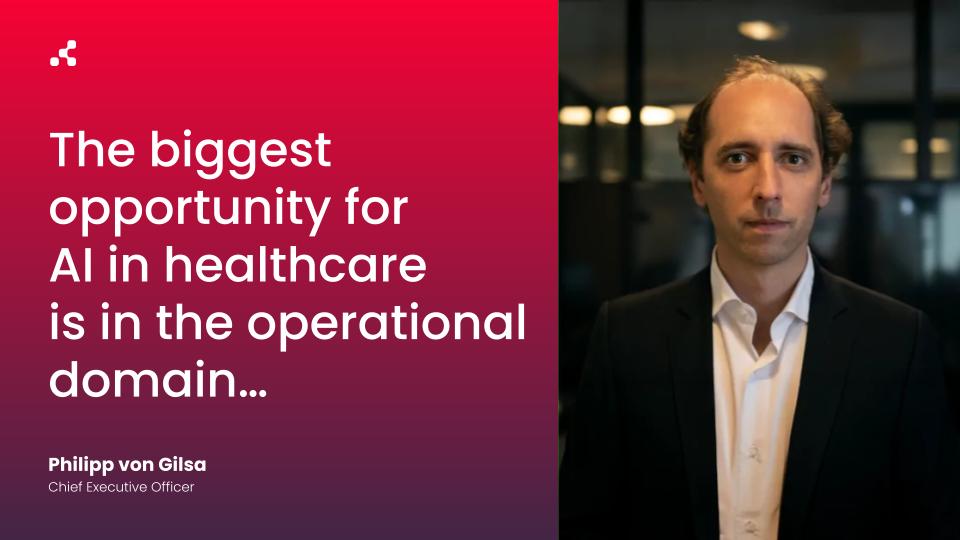AI in healthcare is everywhere — from headlines about breakthrough diagnostics to everyday conversations about workflow automation and staff safety. The question many leaders are asking is simple: what can AI do in healthcare today, and what might it mean for the future?
With rapid development comes a flood of new buzzwords, acronyms, and technical jargon that can be hard to keep up with. These terms are showing up in vendor pitches, strategy meetings, and industry reports — and understanding them is key to making informed decisions.
To cut through the noise, we’ve put together a glossary of useful definitions. It’s a practical reference designed to help professionals quickly get familiar with the language of AI in healthcare and focus on what matters most for patients, staff, and operations.
Artificial Intelligence in Healthcare – Definitions
Accuracy – The degree to which an AI system correctly predicts or classifies outcomes. Accuracy is critical for adoption in both diagnostics and operations.
Algorithm – A defined set of instructions that guide how AI models process healthcare data and generate outputs such as risk scores or predictions.
Anomaly Detection – AI techniques that flag unusual events or data patterns, such as sudden patient deterioration, asset misuse, or security incidents.
Artificial Intelligence (AI) – Technology that simulates human intelligence to perform tasks such as diagnosis, workflow automation, or predictive planning.
Augmented Intelligence – A model where AI enhances — rather than replaces — human decision-making, fostering collaboration and trust.
Autonomous Agents – AI-driven systems capable of acting independently within workflows, for example routing alerts or coordinating bed assignments.
Bias (Algorithmic) – Systematic errors in AI outputs caused by flawed or unrepresentative training data, leading to uneven outcomes across patient groups.
Big Data – Large and complex healthcare datasets that AI systems analyze to detect patterns, optimize operations, or improve care.
Black Box – An AI model whose decision-making process is opaque, raising challenges for clinician trust and regulatory approval.
Chatbot – Conversational AI tools used for tasks such as patient intake, triage, or appointment scheduling.
Clinical Decision Support (CDS) – AI that provides clinicians with patient-specific insights or alerts to improve diagnosis and treatment decisions.
Clinical Decision Support System (CDSS) – Software that integrates CDS into workflows, often embedded in EHRs.
Computer Vision (CV) – AI that interprets medical images such as X-rays or MRIs, supporting faster and more accurate diagnostics.
Data Drift – Shifts in input data that reduce AI performance over time, such as changing patient demographics or equipment behavior.
Data Governance – Policies and practices for ensuring healthcare data is accurate, secure, and ethically used in AI systems.
Data Lake – A repository for storing large volumes of structured and unstructured health data for AI analysis.
Deep Learning (DL) – A subset of machine learning using layered neural networks, widely applied in imaging and diagnostics.
Digital Twin (Patient Digital Twin) – A virtual simulation of a patient used to test treatment options or predict outcomes.
EHR (Electronic Health Record) – The central digital patient record, often the main source of data for healthcare AI tools.
EHR Integration – Embedding AI systems into EHR platforms to deliver insights directly into clinician workflows.
Edge AI – Running AI computations locally on devices, such as wearables or bedside monitors, to enable real-time feedback and stronger privacy.
Explainable AI (XAI) – AI models designed to make their decision-making transparent and understandable to humans.
Federated Learning – Training AI models across multiple organizations without sharing raw data, protecting patient privacy.
Generative AI – AI that creates new outputs, such as drafting clinical notes, generating patient education materials, or synthesizing training data.
Health Informatics – The discipline of managing and analyzing health data, with AI as a growing component for decision support.
HIPAA (Health Insurance Portability and Accountability Act) – U.S. legislation that governs patient data privacy and directly shapes how AI systems must handle PHI.
Human-in-the-Loop (HITL) – A safeguard where clinicians oversee AI outputs to validate accuracy and prevent errors.
Intelligent Orchestration – AI that coordinates multiple hospital systems — from EHRs to RTLS — to optimize workflows and reduce bottlenecks.
Interoperability – The ability for healthcare AI systems to exchange and use data across platforms, such as EHRs and monitoring devices.
Knowledge Graph – A map of medical concepts and relationships, helping AI reason across diseases, treatments, and outcomes.
Machine Learning (ML) – A branch of AI where algorithms learn patterns from healthcare data to make predictions or decisions.
Model Drift – A decline in AI model performance as input data or clinical practices evolve, requiring monitoring and retraining.
Multimodal AI – AI that integrates multiple types of healthcare data (e.g., imaging, lab results, and clinical notes) to improve decision-making.
Natural Language Processing (NLP) – AI that interprets and analyzes unstructured text, such as clinical notes, patient messages, or call transcripts.
PHI (Protected Health Information) – Data that can identify a patient, such as medical records or contact details, subject to strict privacy standards.
Population Health Analytics – AI-driven analysis of population-level data to guide preventive care and reduce costs.
Predictive Analytics – AI techniques that forecast outcomes, such as equipment demand, patient deterioration, or staff safety risks.
Precision Health – Using AI and predictive modeling to personalize prevention and care pathways at the individual level.
Regression Model – A statistical model that predicts continuous outcomes, such as cost of care, recovery time, or likelihood of readmission.
Reinforcement Learning – An AI technique where models learn by receiving feedback from actions, applied in emerging personalized care scenarios.
Responsible AI – Developing and applying AI systems in a way that is ethical, transparent, and accountable.
Revenue Cycle AI – AI applications that improve billing accuracy, reduce claim denials, and speed up reimbursement.
Risk Stratification – Categorizing patients into risk groups (e.g., high readmission risk) to target interventions and resources.
RTLS (Real-Time Location System, AI-powered) – AI-enhanced systems that track equipment, patients, and staff. Hospitals use them to reduce asset loss, improve utilization, and enhance staff safety through duress alerts.
SaMD (Software as a Medical Device) – Software that performs medical functions, often AI-driven, requiring FDA oversight.
Structured Data – Healthcare data stored in predefined formats, such as lab values or billing codes, that AI can process efficiently.
Supervised Learning – An AI training method that uses labeled data to teach systems how to recognize specific patterns.
Synthetic Data – Artificially generated datasets that mimic real patient information, used for AI training while protecting privacy.
Training Data – The data used to teach an AI system to identify patterns or make predictions.
Transfer Learning – Adapting a pre-trained AI model to a new but related problem, helping reduce the need for massive datasets.
Transparency – The ability to understand how an AI system works, crucial for regulatory approval and clinician adoption.
Trust Calibration – Designing AI tools so users neither over-trust nor under-trust them, encouraging appropriate use.
Unstructured Data – Information not organized in predefined formats, such as free-text notes or imaging scans, which often require NLP or CV to analyze.
Value Analysis (in AI) – A structured evaluation of the cost, clinical impact, and ROI of implementing an AI solution.
Value-Based Care – A delivery model focused on outcomes rather than services, where AI supports predictive insights and performance measurement.
Wearable Technology – Devices like biosensors or smartwatches that capture real-time health data, analyzed by AI for monitoring and prevention.
Workflow Integration – Embedding AI into existing clinical or administrative workflows to minimize disruption.
Workflow Optimization – The use of AI to streamline hospital operations, reduce delays, and improve both patient and staff experience.
Page
1


